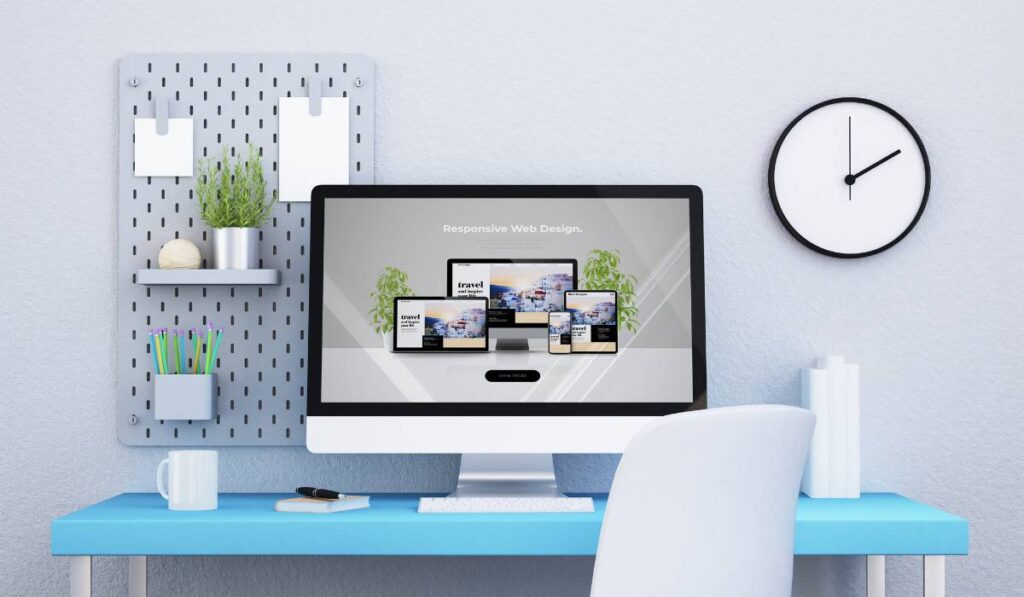Before we delve into the intricacies of web design software, let’s understand its purpose and significance in the digital landscape. Web design software is a collection of applications and tools that enable designers and developers to create, edit, and manage websites efficiently. These software solutions provide a user-friendly interface, allowing users to design websites without extensive coding knowledge.
Ease of Use
One of the primary advantages of web design software is its user-friendly nature. Designers with varying levels of expertise can utilise these tools to bring their creative visions to life. Whether you are a beginner or an experienced professional, it offers intuitive features and drag-and-drop functionalities that simplify the design process. The software eliminates the need to write complex code manually, saving time and effort.
Visual Editors
Web design software often includes visual editors that allow designers to create websites visually, using pre-designed templates or customisable elements. These editors provide a wide range of layouts, colour schemes, typography, and multimedia integration options. Designers can simply drag and drop elements onto the canvas, rearrange them, and preview the changes in real-time. This intuitive approach empowers designers to efficiently iterate and experiment with different design ideas.
Code-Free Design
Gone are the days when extensive coding knowledge was a prerequisite for web design. Web design software has revolutionised the industry by offering code-free design capabilities. These tools generate the underlying code automatically as designers manipulate the visual elements. This feature not only makes web design accessible to a wider audience but also increases productivity by eliminating the need for manual coding.
Feature Set
Web design software comes packed with a diverse range of features that enhance websites’ overall design and functionality. Let’s explore some of the key features that make these tools indispensable for designers and developers.
Responsive Design
In the mobile-dominated era, responsive design is crucial for a successful website. Web design software enables designers to create responsive layouts that adapt seamlessly to different screen sizes and devices. These tools provide preview modes for various devices, allowing designers to ensure their websites look and function flawlessly across desktops, tablets, and smartphones.
Multimedia Integration
Modern websites often rely on multimedia elements to captivate users. Web design software offers seamless integration of images, videos, audio, and interactive content. Designers can easily embed media files into their web pages, adjust settings, and optimise the loading speed without compromising quality. This feature allows designers to create visually rich and engaging websites.

See How my agency can grow your business
- Web Design - Get a website that best describes your business.
- SEO - Outrank competitors and win search engine first pages.
- PPC - Ensure the right action from the right audience.
- SMM - Create more impressions. Feel more connected.

See How my agency can grow your business
- Web Design - Get a website that best describes your business.
- SEO - Outrank competitors and win search engine first pages.
- PPC - Ensure the right action from the right audience.
- SMM - Create more impressions. Feel more connected.
Collaboration and Workflow
Web design software facilitates collaboration among designers, developers, and clients, streamlining the workflow and ensuring efficient project management. Let’s explore some of the collaborative features that these tools offer.
Version Control
Design projects involve multiple iterations and revisions. This software provides version control capabilities, enabling designers to track changes, revert to previous versions, and collaborate seamlessly. This feature ensures smooth communication and eliminates confusion among team members.
Commenting and Feedback
To facilitate effective collaboration, web design software allows stakeholders to provide feedback and comments directly on the design prototypes. This real-time feedback mechanism ensures that all parties are on the same page, resulting in a more refined and polished final product.
Customisation Options
Web design software offers various customisation options, allowing designers to create unique and personalised websites. Let’s explore some of the key customisation features that these tools provide.
Template Libraries
Web design software often includes extensive libraries of pre-designed templates. Designers can choose from a variety of themes and layouts that align with their project requirements. These templates serve as a starting point, providing a foundation that can be customised to create a distinct website.
Styling and Branding
To create a cohesive and visually appealing website, web design software offers robust styling and branding options. Designers can customise colours, fonts, typography, and other visual elements to match the brand identity and convey the desired message. This level of customisation ensures consistency and reinforces the brand’s presence.
Search Engine Optimization (SEO) Features
In today’s digital landscape, having a website that ranks well in search engine results is crucial for visibility and attracting organic traffic. Web design software includes built-in SEO features to optimise websites for search engines. Let’s explore some of these key SEO functionalities.
Meta Tags and Descriptions
Web design software allows designers to add meta tags and descriptions to web pages. These elements provide search engines with information about the content of the page, improving its visibility in search results. Designers can optimise meta tags and descriptions with relevant keywords to enhance the website’s SEO performance.
URL Structure and Site Navigation
Good URL structure and site navigation are essential for search engine crawlers to understand and index the website’s content effectively. Web design software enables designers to create clean and user-friendly URLs and establish logical site navigation. This ensures that search engines can easily navigate and rank the website’s pages.
Responsive Testing and Optimization
With the increasing use of mobile devices, it is crucial for websites to provide a seamless user experience across different screen sizes. Web design software offers responsive testing and optimisation features to ensure that websites look and function flawlessly on various devices. Let’s explore these functionalities.
Device Preview and Testing
Web design software allows designers to preview and test websites on different devices and screen sizes. This feature enables them to identify any layout or functionality issues and make necessary adjustments to ensure a consistent experience for users across platforms. Let’s take a closer look at the device preview and testing capabilities.
Device Emulation
Web design software provides device emulation tools that simulate the display and behaviour of various devices. Designers can choose from a wide range of devices, including smartphones, tablets, and desktop computers, to preview their websites. This feature allows designers to visualise how their website will appear on different devices and make design decisions accordingly.
Responsive Breakpoints
Responsive web design relies on defining breakpoints, which are specific screen sizes where the layout of a website changes to accommodate different devices. Web design software allows designers to set and customise these breakpoints, ensuring that the website adapts seamlessly to various screen sizes. Designers can preview and test their website at each breakpoint to ensure optimal responsiveness.
Interactive Testing
To ensure a seamless user experience, web design software enables designers to interact with the website in the testing phase. Designers can click buttons, fill out forms, and navigate through the website as if they were a user. This interactive testing helps identify functional issues, such as broken links or non-responsive elements and allows designers to make the necessary adjustments before launching the website.
Performance Optimization
In addition to responsive testing, web design software includes tools to optimise website performance. A fast-loading website is crucial for user satisfaction and search engine rankings. Let’s explore some of the performance optimisation techniques offered by this software.
Image Compression
Images play a vital role in web design, but large file sizes can significantly impact website performance. Web design application provides image compression tools that reduce the file size of images without compromising their quality. By optimising images, designers can improve page load times and ensure a smooth browsing experience for users.
Code Minification
Web design software includes code minification features that remove unnecessary characters, spaces, and line breaks from HTML, CSS, and JavaScript code. Minified code reduces the overall file size, resulting in faster loading times. By optimising the code, designers can enhance website performance and improve the efficiency of the website’s delivery to users.
Caching Mechanisms
Web design software often integrates caching mechanisms that store frequently accessed files on the user’s device. By caching static files, such as CSS and JavaScript, the website can load faster on subsequent visits. Caching reduces the need to re-download files, resulting in improved performance and a better user experience.
Performance Analysis
Web design software may also offer performance analysis tools that provide insights into website speed, loading times, and performance metrics. Designers can use these tools to identify areas for improvement and optimise the website’s performance. By addressing performance issues, designers can enhance user satisfaction and increase the chances of higher search engine rankings.
Conclusion
Web design software empowers designers and developers to create visually stunning and highly functional websites without the need for extensive coding knowledge. Its user-friendly interface, drag-and-drop functionalities, and diverse feature set make web design accessible to a wider audience. With Responsive Testing and Optimization capabilities, multimedia integration, and collaborative features, this software has become an indispensable tool in the digital era.
Boost Your Web Design Process with VentCube
Are you looking to take your web design process to the next level? Look no further! Experience the power and efficiency of VentCube, the ultimate web design software. With its intuitive interface, drag-and-drop functionality, and comprehensive set of features, VentCube empowers you to create stunning and functional websites with ease. Contact us today!!



